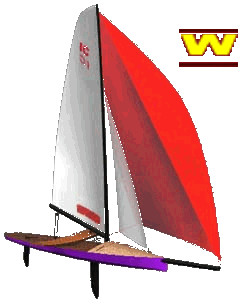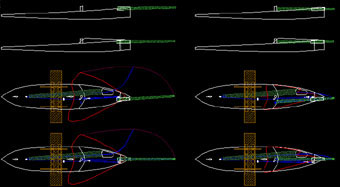|
Rob Michael writes:
The asymmetric development came
from a frustration of doing the same old thing year in & needed a change but there isn't anything out there as good as a standard canoe anyway, so hence the turbo. I have been playing with standard kites for years to improve the downwind performance, but the kite boom was always the drawback when gibing so with the increase in popularity in asymmetric kites using a bowsprit, gibing has become no problem at all.
The main design problems I had to overcome as its a singlehanded boat was to launch & retrieve it with only one hand. 18 months of drawings & models & I came up with the systems I now use. I still thought that the kite would probably be too much of a handful to sail in stronger winds & had no intention of doing it for anyone else. But how wrong could I be? Without exception, anyone who has seen it in action has wanted to convert, not even having actually tried it for themselves. It has proved easy to hoist & drop,the size has increased all the way up to 18.5 sq.. m & is easy to sail in any winds. Sailing up wind in a breeze & tacking are still the hardest part.
It has taken me the last 16 months of racing it in all conditions & 5 kites to come up with the right kite size/shape & material. This is critical for ease of use, visibility & max performance against all the other classes we race against. I have to date converted 17 boats & have 3 under conversion with 4 lined up. These including the current world champ, 4 National champs & most of the comparative fleet. So I guess you could say its happening.
Rob writes also that Bill Beaver (US Pres.) & Dave Gilliland (US) payed him a visit & he showed them how he does the conversion. Dave has bought a kite off Rob & is getting Bill to convert "Arrested Development"? for him. ...So I guess you could say its happening.
| 

